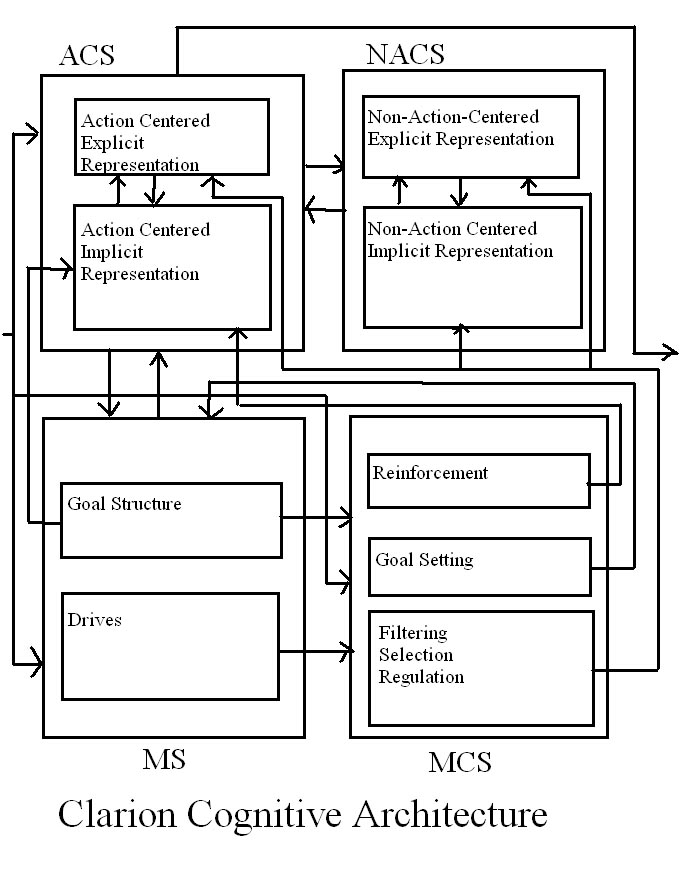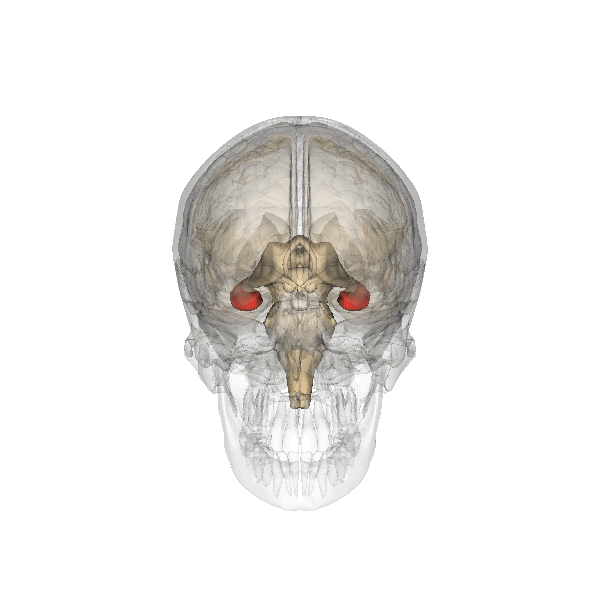|
CLARION (cognitive Architecture)
Connectionist Learning with Adaptive Rule Induction On-line (CLARION) is a computational cognitive architecture that has been used to simulate many domains and tasks in cognitive psychology and social psychology, as well as implementing intelligent systems in artificial intelligence applications. An important feature of CLARION is the distinction between implicit and explicit processes and focusing on capturing the interaction between these two types of processes. The system was created by the research group led by Ron Sun. Overview CLARION is an integrative cognitive architecture. It is used to explain and simulate cognitive-psychological phenomena, which could potentially lead to an unified explanation of psychological phenomena. There are three layers to the CLARION theory. The first layer is the core theory of mind. The main theories consists of a number of distinct subsystems, which are the essential structures of CLARION, with a dual representational structure in each su ... [...More Info...] [...Related Items...] OR: [Wikipedia] [Google] [Baidu] |
Cognitive Architecture
A cognitive architecture is both a theory about the structure of the human mind and to a computational instantiation of such a theory used in the fields of artificial intelligence (AI) and computational cognitive science. These formalized models can be used to further refine comprehensive theories of cognition and serve as the frameworks for useful artificial intelligence programs. Successful cognitive architectures include ACT-R (Adaptive Control of Thought – Rational) and SOAR. The research on cognitive architectures as software instantiation of cognitive theories was initiated by Allen Newell in 1990. A theory for a cognitive architecture is an "''hypothesis about the fixed structures that provide a mind, whether in natural or artificial systems, and how they work together — in conjunction with knowledge and skills embodied within the architecture — to yield intelligent behavior in a diversity of complex environments." History Herbert A. Simon, one of the founders ... [...More Info...] [...Related Items...] OR: [Wikipedia] [Google] [Baidu] |
Connectionism
Connectionism is an approach to the study of human mental processes and cognition that utilizes mathematical models known as connectionist networks or artificial neural networks. Connectionism has had many "waves" since its beginnings. The first wave appeared 1943 with Warren Sturgis McCulloch and Walter Pitts both focusing on comprehending neural circuitry through a formal and mathematical approach, and Frank Rosenblatt who published the 1958 paper "The Perceptron: A Probabilistic Model For Information Storage and Organization in the Brain" in ''Psychological Review'', while working at the Cornell Aeronautical Laboratory. The first wave ended with the 1969 book about the limitations of the original perceptron idea, written by Marvin Minsky and Seymour Papert, which contributed to discouraging major funding agencies in the US from investing in connectionist research. With a few noteworthy deviations, most connectionist research entered a period of inactivity until the mid-1980 ... [...More Info...] [...Related Items...] OR: [Wikipedia] [Google] [Baidu] |
Consciousness
Consciousness, at its simplest, is awareness of a state or object, either internal to oneself or in one's external environment. However, its nature has led to millennia of analyses, explanations, and debate among philosophers, scientists, and theologians. Opinions differ about what exactly needs to be studied or even considered consciousness. In some explanations, it is synonymous with the mind, and at other times, an aspect of it. In the past, it was one's "inner life", the world of introspection, of private thought, imagination, and volition (psychology), volition. Today, it often includes any kind of cognition, experience, feeling, or perception. It may be awareness, awareness of awareness, metacognition, or self-awareness, either continuously changing or not. The disparate range of research, notions, and speculations raises a curiosity about whether the right questions are being asked. Examples of the range of descriptions, definitions or explanations are: ordered distinc ... [...More Info...] [...Related Items...] OR: [Wikipedia] [Google] [Baidu] |
Creativity
Creativity is the ability to form novel and valuable Idea, ideas or works using one's imagination. Products of creativity may be intangible (e.g. an idea, scientific theory, Literature, literary work, musical composition, or joke), or a physical object (e.g. an invention, dish or meal, piece of Jewellery, jewelry, costume, a painting). Creativity may also describe the ability to find Creative problem-solving, new solutions to problems, or new methods to accomplish a goal. Therefore, creativity enables people to Solves problem, solve problems in new ways. Most ancient cultures (including Ancient Greece, History of China#Ancient China, Ancient China, and Outline of ancient India, Ancient India) lacked the concept of creativity, seeing art as a form of discovery rather than a form of creation. In the Judeo-Christian-Islamic tradition, creativity was seen as the sole province of God, and human creativity was considered an expression of God's work; the modern conception of creativi ... [...More Info...] [...Related Items...] OR: [Wikipedia] [Google] [Baidu] |
Soar (cognitive Architecture)
Soar is a cognitive architecture, originally created by John Laird, Allen Newell, and Paul Rosenbloom at Carnegie Mellon University. The goal of the Soar project is to develop the fixed computational building blocks necessary for general intelligent agents – agents that can perform a wide range of tasks and encode, use, and learn all types of knowledge to realize the full range of cognitive capabilities found in humans, such as decision making, problem solving, planning, and natural-language understanding. It is both a theory of what cognition is and a computational implementation of that theory. Since its beginnings in 1983 as John Laird’s thesis, it has been widely used by AI researchers to create intelligent agents and cognitive models of different aspects of human behavior. The most current and comprehensive description of Soar is the 2012 book, ''The Soar Cognitive Architecture.'' Rosenbloom continued to serve as co-principal investigator after moving to Stanford Univ ... [...More Info...] [...Related Items...] OR: [Wikipedia] [Google] [Baidu] |
ACT-R
ACT-R (pronounced /ˌækt ˈɑr/; short for "Adaptive Control of Thought—Rational") is a cognitive architecture mainly developed by John Robert Anderson and Christian Lebiere at Carnegie Mellon University. Like any cognitive architecture, ACT-R aims to define the basic and irreducible cognitive and perceptual operations that enable the human mind. In theory, each task that humans can perform should consist of a series of these discrete operations. Most of the ACT-R's basic assumptions are also inspired by the progress of cognitive neuroscience, and ACT-R can be seen and described as a way of specifying how the brain itself is organized in a way that enables individual processing modules to produce cognition. Inspiration ACT-R has been inspired by the work of Allen Newell, and especially by his lifelong championing the idea of unified theories as the only way to truly uncover the underpinnings of cognition. In fact, Anderson usually credits Newell as the major source of infl ... [...More Info...] [...Related Items...] OR: [Wikipedia] [Google] [Baidu] |
One-shot Learning (computer Vision)
One-shot learning is an object categorization problem, found mostly in computer vision. Whereas most machine learning-based object categorization algorithms require training on hundreds or thousands of examples, one-shot learning aims to classify objects from one, or only a few, examples. The term few-shot learning is also used for these problems, especially when more than one example is needed. Motivation The ability to learn object categories from few examples, and at a rapid pace, has been demonstrated in humans. It is estimated that a child learns almost all of the 10 ~ 30 thousand object categories in the world by age six. This is due not only to the human mind's computational power, but also to its ability to synthesize and learn new object categories from existing information about different, previously learned categories. Given two examples from two object categories: one, an unknown object composed of familiar shapes, the second, an unknown, amorphous shape; it is much ... [...More Info...] [...Related Items...] OR: [Wikipedia] [Google] [Baidu] |
Motivation
Motivation is an mental state, internal state that propels individuals to engage in goal-directed behavior. It is often understood as a force that explains why people or animals initiate, continue, or terminate a certain behavior at a particular time. It is a complex phenomenon and its precise definition is disputed. It contrasts with #Amotivation and akrasia, amotivation, which is a state of apathy or listlessness. Motivation is studied in fields like psychology, neuroscience, motivation science, and philosophy. Motivational states are characterized by their direction, Motivational intensity, intensity, and persistence. The direction of a motivational state is shaped by the goal it aims to achieve. Intensity is the strength of the state and affects whether the state is translated into action and how much effort is employed. Persistence refers to how long an individual is willing to engage in an activity. Motivation is often divided into two phases: in the first phase, the indi ... [...More Info...] [...Related Items...] OR: [Wikipedia] [Google] [Baidu] |
Action (philosophy)
In philosophy, an action is something an Agency (philosophy), agent does. Actions contrast with events which merely happen to someone and are typically performed for a Goal, purpose and guided by an intention. The first question in the Action theory (philosophy), philosophy of action is to determine how actions differ from other forms of behavior, like Reflex, involuntary reflexes. According to Ludwig Wittgenstein, it involves discovering "What is left over if I subtract the fact that my arm goes up from the fact that I raise my arm". A common response to this question focuses on the agent's intentions. So driving a car is an action since the agent intends to do so, but sneezing is a mere behavior since it happens independent of the agent's intention. The dominant theory of the relation between the intention and the behavior is ''causalism'': driving the car is an action because it is ''caused'' by the agent's intention to do so. On this view, actions are distinguished from other ... [...More Info...] [...Related Items...] OR: [Wikipedia] [Google] [Baidu] |
Artificial Neural Network
In machine learning, a neural network (also artificial neural network or neural net, abbreviated ANN or NN) is a computational model inspired by the structure and functions of biological neural networks. A neural network consists of connected units or nodes called '' artificial neurons'', which loosely model the neurons in the brain. Artificial neuron models that mimic biological neurons more closely have also been recently investigated and shown to significantly improve performance. These are connected by ''edges'', which model the synapses in the brain. Each artificial neuron receives signals from connected neurons, then processes them and sends a signal to other connected neurons. The "signal" is a real number, and the output of each neuron is computed by some non-linear function of the sum of its inputs, called the '' activation function''. The strength of the signal at each connection is determined by a ''weight'', which adjusts during the learning process. Typically, ne ... [...More Info...] [...Related Items...] OR: [Wikipedia] [Google] [Baidu] |
Declarative Memory
Explicit memory (or declarative memory) is one of the two main types of Long-term memory, long-term human memory, the other of which is implicit memory. Explicit memory is the Consciousness, conscious, intentional Recall (memory), recollection of factual information, previous experiences, and concepts. This type of memory is dependent upon three processes: acquisition, Memory Consolidation, consolidation, and retrieval. Explicit memory can be divided into two categories: episodic memory, which stores specific Experience, personal experiences, and semantic memory, which stores factual information.Tulving E. 1972. Episodic and semantic memory. In Organization of Memory, ed. E Tulving, W Donaldson, pp. 381–403. New York: Academic Explicit memory requires gradual learning, with multiple presentations of a Stimulus (psychology), stimulus and response. The type of knowledge that is stored in explicit memory is called declarative knowledge. Its counterpart, known as implicit memory, re ... [...More Info...] [...Related Items...] OR: [Wikipedia] [Google] [Baidu] |




